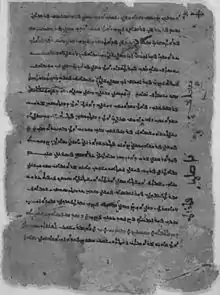Bulayïq
Bulayïq(Chinese: 葡萄沟) is a locality and archaeological site in central Xinjiang province in western China. It is located 10km north of Turpan city in the foothills of the Tien-shan Mountains.[1] It is also known as Bīlayuq[2]
The site in the Tapin basin is arid. The remains there include a Tell with mud brick ruins protruding from the desert sands. The ruins were excavated by a German team in 1905, led by A. von Le Coq.[3][4][5]

Among the ruins was found a monastic library, where a trove of ancient manuscripts in various Iranian languages were found.[6] The texts show the influence of Orthodox and Nestorian Churches. Almost all known Christian religious texts in the ancient Sogdian language are from the Bīlayuq library.[7] The texts show the development and spread of Christianity in central Asia.[8]
References
- Nicholas Sims-Williams, http://www.iranicaonline.org/articles/bulayq-town-in-eastern-turkestan#prettyPhoto BULAYÏQ], Encyclopedea Iranica.
- P. Zieme, Türk dili araştırma yıllığı belleten; 1978-79, Ankara, 1981, p. 90
- Le Coq, Albert von Auf Hellas Spuren in Ost-Turkestan. Berichte und Abenteuer der II. und III. deutschen Expeditionen, Leipzig, 1926, p. 88
- JRAS, 1909, pp. 319 and 321
- Adrien Pitea, St. Isaac of Nineveh’s Gnostic Chapters in Sogdian: The Identification of an Anonymous Text from Bulayïq 2020.
- Erica C. D. Hunter, Syriac Sogdian and Old Uyghur manuscripts from Bulayiq.
- Scott Fitzgerald Johnson, The Oxford Handbook of Late Antiquity (Oxford University Press, 2015) page 1021.
- Nicola Di Cosmo; Michael Maas, Empires and Exchanges in Eurasian Late Antiquity: Rome, China, Iran, and the Steppe, ca. 250–750 (Cambridge University Press, 26 Apr. 2018 ) p 211-213